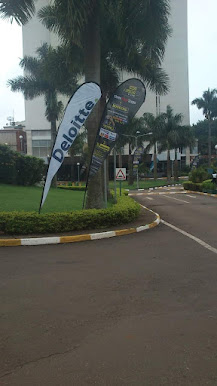iSPECIAL MOBILITY ECOSYSTEM
Strategic Partnership and Collaboration Aspirations
FOREWORD│ MAK AND STANBIC DISCUSS PARTNERSHIP BEYOND BANKING
At the beginning of the second quarter instant (Q2:2021), and upon being prompted by the Acting (Ag.) Deputy Vice Chancellor – Finance and Administration (DVCFA), Dr. Josephine Nabukenya's engagement with Ms. Anne Juuko, Former Chief Executive, Stanbic Bank Uganda (SBU); Makerere University convened a Special Session of the members of the Central Management with a view to partner with SBU in delivering the University ten year Strategic Objectives. The vision for the ten year (2020 -2030) Strategic Plan is : "a thought leader of knowledge generation for societal transformation and development."
"Makerere University's first Strategic goal to translate into a research-led University requires a lot of thinking through on how the different services can be rehabilitated into frameworks that support our vision," remarked Dr. Nabukenya.
The Ag. DVCFA was speaking in reference to the Research and Innovation Ecosystem that needs to be created to ensure that Makerere's research will over the next 10 years have demonstrable economic, environmental, health and social impact.
"The Vice Chancellor appreciated the Ag.DVCFA for initiating the discussion with SBU, noting that this was timely and would help take advantage of the huge potential that the University has to offer; "Thanks to funding from the Government of Uganda through the Makerere Research and Innovation Fund (Mak-RIF) we now have hundreds of Innovations produced by various research teams."
"Our biggest problem at present is the lack of funds to commercialize these innovations. Uganda has no Venture Capitalists but I believe that with the resources that you (SBU) have, we can work together to help support these Innovations," remarked Prof. Barnabas Nawangwe.
Prior to making her presentation, Ms. Anne Juuko thanked Makerere University for supporting SBU's business thus far, as well as ensuring that the two partners enjoy a quality relationship with each others successive Management Teams. "We take extra pride when it comes to working with Makerere University," she added.
Further Ms. Juuko said that the reorganization of SBU in 2018 to include a Holding Company: Stanbic Holdings Uganda Limited (SHUL) had enabled the entity to enhance the value of the products and services offered to its customers. In addition to SBU,other SHUL subsidiaries include: Stanbic Properties Uganda Limited, FlyHub and SBG Securities , these, she noted enabled Stanbic to offer a broader range of services beyond banking."
"Reflecting on the signing of the Host Government Agreement between the Government of the Republic of Uganda and the EACOP Company – a precursor Agreement leading to the Final Investment Decision (FID) which was signed on 11th April 2021, the CE shared that SBU in line with its support for responsible Investment through assessing and managing Environmental, Social and Governance (ESG) risks would take keen interest in Oil Production. "One of the hottest topics is that Oil mining is going to take place in one of the most ecologically sensitive zones. How can we partner with Makerere to ensure that this is conducted in a sustainable way?" she pondered.
"The CE also brought to the attention of the University Central Management that SBU had in 2020 partnered with the United Nations Development Programme (UNDP) to launch the Youth4Business Innovation and Entrepreneurial Facility as an answer to youth unemployment. As a way forward, she added that Makerere would be brought on board to form a three-way conversation on how best to achieve the facility's Objectives, especially following disruptions to Micro, Small, and Medium (MSME's) operations caused by COVID-19.
Courtesy: news.mak.ac.ug By: Mark Wamai
Extra of Anne Juuko's Related Nuggets of Wisdom:
"Success in the Corporate world is delivering Value to a larger Society. For Success, Open yourself to Cooperation and Collaboration. The solution is in partnership." – Anne Juuko, Former Chief Executive, Stanbic Uganda [Updated on Monday, 8th December, 2025]. She was speaking to the need to be agile in a changing world.
Partnership Engagement Mechanics
A. iSpecial/Quartz/MNO/Hertz customers pay using Cash, Debit Card/Credit Cards, and/or Mobile Money/Airtel Money to the Service Centre as they come to buy Partner Retail Chain Goods and Services. The Physical Cash is later banked In-house within the Service station and/or remitted/deposited to the iSpecial/Quartz/Hertz collection Account;
B. The surplus Physical Cash from the Service Centre is exchanged with the surplus Electronic Money held by the iSpecial/Quartz/Hertz Super Agency terminal domiciled at the Service Centre;
C. The Electronic Money from the Partner Service Centre shall be remitted to the MNO Head Office Treasury Department while, the Physical Cash now held by iSpecial/Quartz/Hertz Super Agency will be distributed to the Aggregated Mobile Money outlets clustered around the participating Partner Service Stations;
D. The MNO Head Office in the capacity of a Trust Party of the Partner Service Centre and iSpecial/Quartz/Hertz/Super Agency will on a quid pro quo basis remit the Electronic Mobile Money Float and realize the Electronic Funds Transfer from the parties respectively using the Third Party platforms at their disposal as shall be mutually agreed by the parties and specifically provided for in (E) and (F) below.
E. The liquidity portfolio re-balancing between the parties shall be managed via the online banking platform by use of a combination of the Collection Accounts and the Inter-party Settlement Accounts;
F. The parties will then have the responsibility to trigger the Electronic Funds Transfer to the MNO Head Office Treasury Department as per the agreed mandate to operate the Escrow/Inter-Party Settlement Account at the Bank;
G. The Head Office treasury shall then dispose the Aggregated Partner obligations in respect of the Business to Business Supply Chain to enable it access the requisite products;
H. The Business to Business Unit will then supply the Bulk Products to the Service Stations as per their requisite Products. (This applies to a downstream Oil distribution Partner)
Concluding Remark:
The parties shall mutually benefit from the enhanced customer acquisition at the Service Stations that will translate into enhanced performance while eliminating any redundant Physical Cash at the site warranting a Physical movement to the Bank.






















